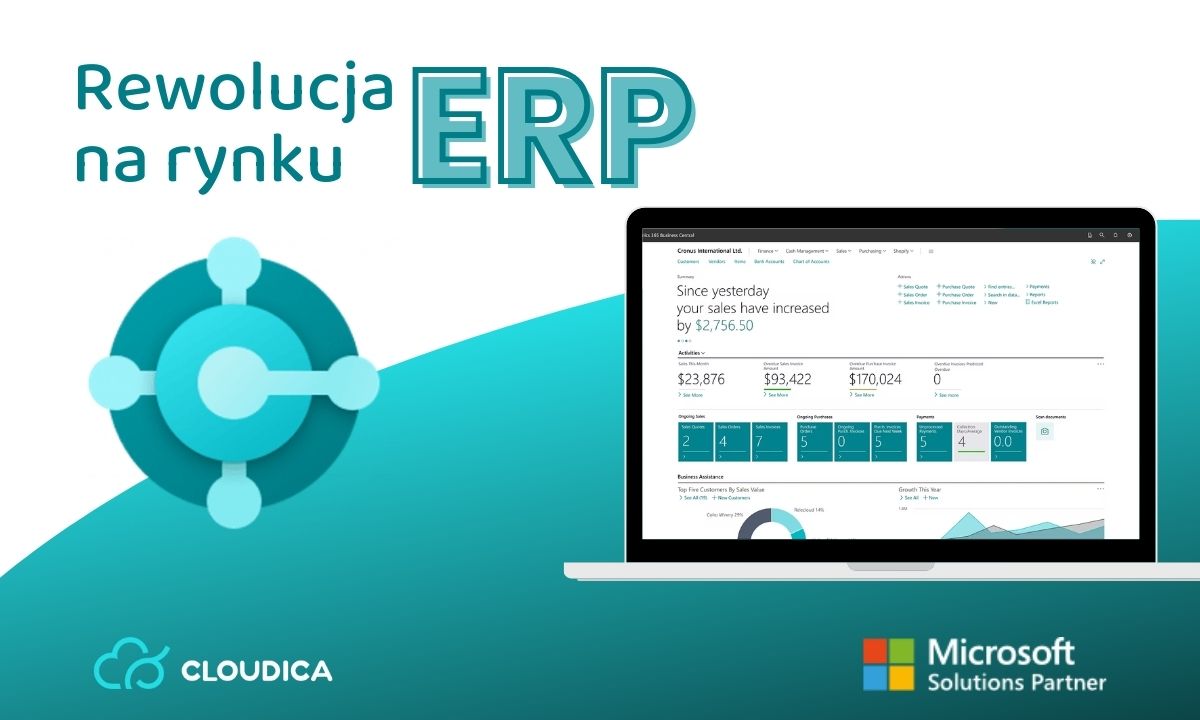Systemy planowania zasobów przedsiębiorstwa (ERP) są kluczowym elementem operacji biznesowych, pomagając firmom usprawniać procesy, poprawiać podejmowanie decyzji i zwiększać ogólną efektywność. Wśród wielu dostępnych rozwiązań ERP, Microsoft Dynamics 365 Business Central wyróżnia się jako przełomowe rozwiązanie dla małych i średnich przedsiębiorstw. Ten artykuł bada, jak Business Central rewolucjonizuje rynek ERP i porównuje go z Microsoft Dynamics 365 Finance and Operations.
Ewolucja ERP z Business Central
Microsoft Business Central został zaprojektowany jako kompleksowe rozwiązanie do zarządzania biznesem, które integruje finanse, sprzedaż, łańcuch dostaw, zarządzanie projektami i operacje. Jest to rozwiązanie oparte na chmurze, skalowalne i w pełni zintegrowane z innymi rozwiązaniami Microsoft, w tym Microsoft 365 i Power Platform.
Niektóre z kluczowych sposobów, w jakie Business Central przekształca krajobraz ERP, obejmują:
- Podejście Cloud-First: Business Central jest zbudowany na infrastrukturze chmurowej, co pozwala firmom korzystać z mocy zdalnego dostępu, automatycznych aktualizacji i zmniejszonych kosztów IT.
- Bezproblemowa integracja: Dzięki natywnej integracji z aplikacjami Microsoft 365, takimi jak Outlook, Teams i Excel, użytkownicy mogą zarządzać finansami, interakcjami z klientami i raportowaniem bez konieczności zmiany platform.
- AI i automatyzacja: Business Central wykorzystuje narzędzia oparte na AI, takie jak prognozowanie przepływów pieniężnych i automatyczne przetwarzanie faktur, aby poprawić podejmowanie decyzji i efektywność.
- Dostosowanie i rozszerzalność: Dzięki Microsoft AppSource firmy mogą łatwo dostosować Business Central za pomocą aplikacji firm trzecich i rozwiązań specyficznych dla branży.
- Przyjazny interfejs użytkownika: Nowoczesny i intuicyjny interfejs zapewnia, że użytkownicy mogą szybko się przystosować i maksymalizować produktywność.
Business Central vs. Microsoft Dynamics 365 Finance and Operations
Chociaż zarówno Business Central, jak i Microsoft Dynamics 365 Finance and Operations (D365 F&O) są częścią pakietu Dynamics 365, są skierowane do różnych potrzeb biznesowych:
Dlaczego Business Central jest przełomowy
Dla małych i średnich przedsiębiorstw Business Central oferuje idealne połączenie przystępności, funkcjonalności i łatwości użytkowania. W przeciwieństwie do tradycyjnych rozwiązań ERP, które wymagają znacznych inwestycji początkowych i rozległego dostosowania, Business Central zapewnia gotowe rozwiązanie z elastyczną skalowalnością.
Dodatkowo, jego zgodność z szerszym ekosystemem Microsoft zapewnia, że firmy mogą korzystać z AI, automatyzacji i analityki bez konieczności posiadania oddzielnej infrastruktury IT. Modułowe podejście Business Central pozwala firmom stopniowo wdrażać funkcjonalność ERP, zapewniając, że skalują się efektywnie bez przytłaczania zasobów.
Wnioski
Microsoft Dynamics 365 Business Central redefiniuje rynek ERP, oferując skalowalne, oparte na chmurze i w pełni zintegrowane rozwiązanie dostosowane do małych i średnich przedsiębiorstw. Podczas gdy Microsoft Dynamics 365 Finance and Operations pozostaje preferowaną opcją dla dużych przedsiębiorstw o złożonych potrzebach, Business Central zapewnia intuicyjne, opłacalne i potężne rozwiązanie ERP, które odpowiada współczesnym wymaganiom biznesowym.
W miarę jak firmy nadal przyjmują transformację cyfrową, rozwiązania takie jak Business Central będą odgrywać kluczową rolę w upraszczaniu wdrażania ERP i napędzaniu długoterminowego wzrostu.
[ENG]
How Microsoft Business Central is Revolutionizing the ERP Market
Enterprise Resource Planning (ERP) systems are at the core of business operations, helping companies streamline processes, improve decision-making, and enhance overall efficiency. Among the many ERP solutions available, Microsoft Dynamics 365 Business Central is making waves as a game-changer for small to mid-sized businesses. This article explores how Business Central is revolutionizing the ERP market and compares it to Microsoft Dynamics 365 Finance and Operations.
The Evolution of ERP with Business Central
Microsoft Business Central is designed to provide an all-in-one business management solution that integrates finance, sales, supply chain, project management, and operations. It is cloud-based, scalable, and fully integrated with other Microsoft solutions, including Microsoft 365 and Power Platform.
Some of the key ways Business Central is transforming the ERP landscape include:
- Cloud-First Approach: Business Central is built on a cloud infrastructure, allowing businesses to leverage the power of remote access, automatic updates, and reduced IT overhead.
- Seamless Integration: With native integration to Microsoft 365 applications like Outlook, Teams, and Excel, users can manage financials, customer interactions, and reporting without switching platforms.
- AI and Automation: Business Central leverages AI-driven insights and automation tools, such as AI-powered cash flow forecasting and automated invoice processing, to enhance decision-making and efficiency.
- Customization and Extensibility: Through Microsoft’s AppSource, companies can easily customize Business Central with third-party applications and industry-specific solutions.
- User-Friendly Interface: A modern and intuitive interface ensures that users can quickly adapt and maximize productivity.
Business Central vs. Microsoft Dynamics 365 Finance and Operations
While both Business Central and Microsoft Dynamics 365 Finance and Operations (D365 F&O) are part of the Dynamics 365 suite, they cater to different business needs:
Why Business Central is a Game-Changer
For small and mid-sized businesses, Business Central offers the perfect blend of affordability, functionality, and ease of use. Unlike traditional ERP solutions that require significant upfront investment and extensive customization, Business Central provides an out-of-the-box solution with flexible scalability.
Additionally, its alignment with the broader Microsoft ecosystem ensures that companies can leverage AI, automation, and analytics without requiring a separate IT infrastructure. The modular approach of Business Central allows companies to adopt ERP functionality gradually, ensuring that they scale efficiently without overwhelming resources.
Conclusion
Microsoft Dynamics 365 Business Central is redefining the ERP market by offering a scalable, cloud-based, and fully integrated solution tailored for small to mid-sized businesses. While Microsoft Dynamics 365 Finance and Operations remains the go-to option for large enterprises with complex needs, Business Central provides an intuitive, cost-effective, and powerful ERP solution that aligns with modern business demands.
As businesses continue to embrace digital transformation, solutions like Business Central will play a crucial role in simplifying ERP adoption and driving long-term growth.


